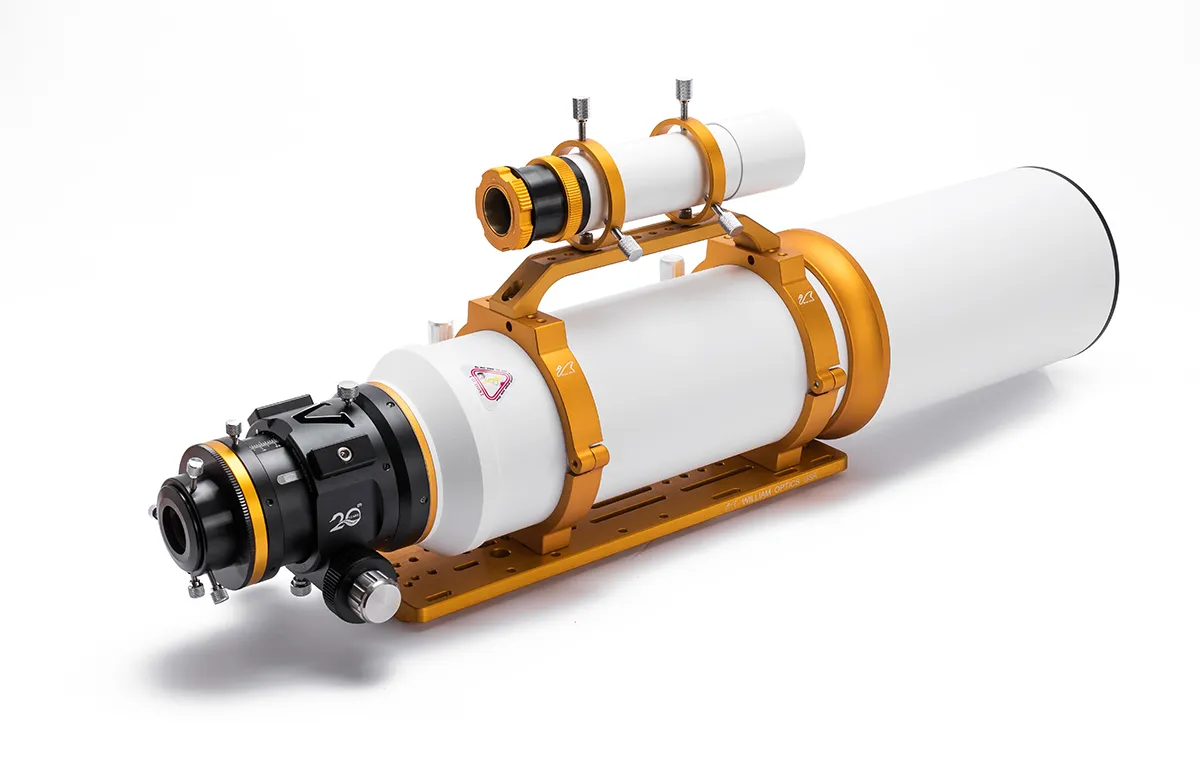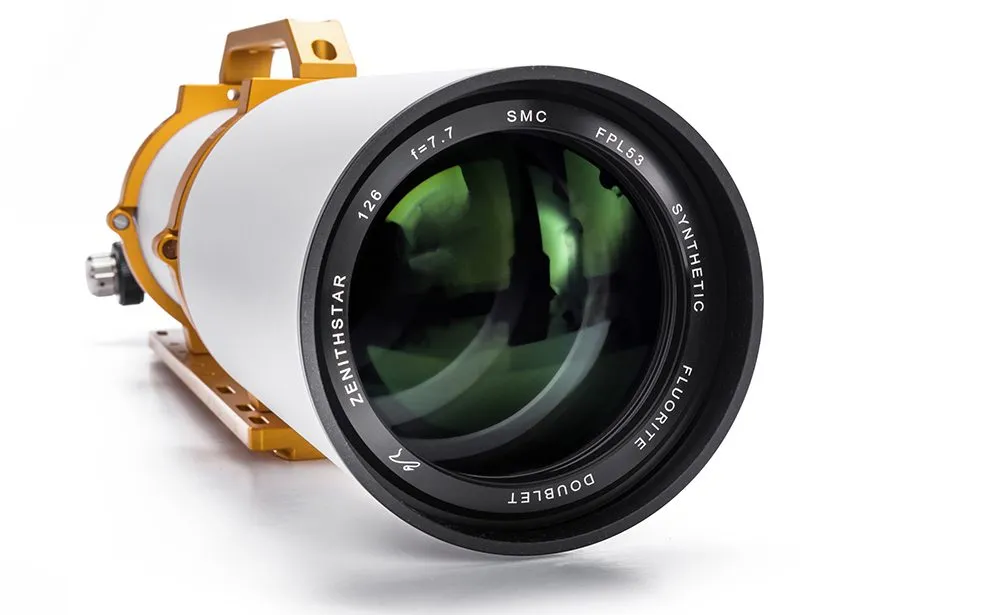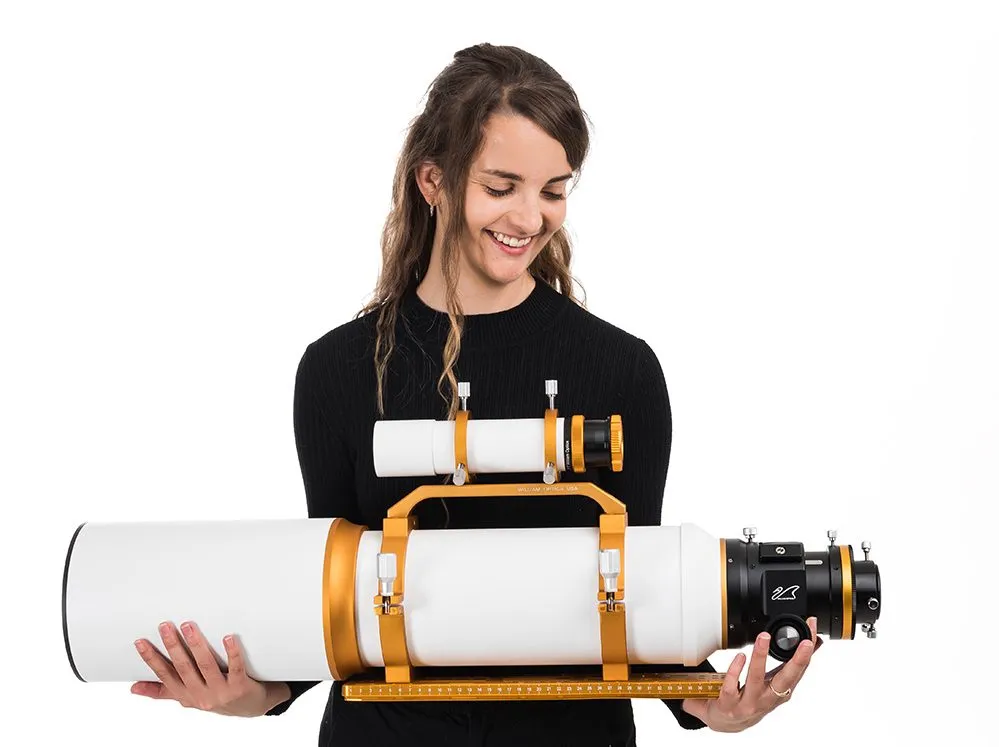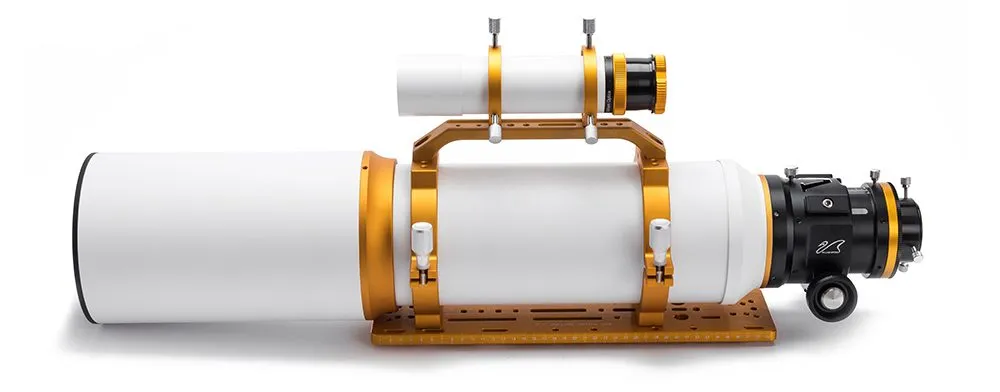The Zenithstar 126mm refractor (ZS126) from William Optics is among the best looking telescopes we have reviewed. With a matching coloured trim throughout, the ZS126 oozes style, but, more importantly, the attention to detail given to styling has also gone into functionality.
It boasts an impressive range of practical features. As refractors go, four-inch models occupy a favourable spot between performance and portability, and the ZS126 is no exception.
Despite its solid design, its weight is less than 10kg and, with the large dew shield retracted, it’s just 800mm long.
The scope has an integrated handle and finderscope rail, which works together with CNC tube rings and a premium Losmandy-style dovetail bar to provide a reliable platform for the instrument.
Our review package included an optional 50mm guidescope, which made a beautiful set.
Galaxy quest
With this impressive appearance, we were keen to see how the ZS126 actually performed.
The lens is f/7.7, giving a focal length of 970mm, making the scope suited for observing, or astrophotography with an optional field-flattening lens.
We didn’t have the flattener available but used the first clear sky opportunity to run basic tests with a mono CCD camera and filters.
This demonstrated that the doublet lens produced good, sharp, round star images, and that red, green and blue wavelengths came to close focus together.
Despite the lack of a flattening lens, there was barely any sign of coma using our Sony 460 size CCD, so we decided to try a few imaging sessions using a one-shot colour version of the camera.
Targets like globular clusters were nicely presented at a good scale, and we enjoyed our time imaging M13 and M92 in Hercules.
The Whirlpool Galaxy, M51, showed what the scope was capable of on galaxies, and we were impressed that the four small but more noticeable stars within the Ring Nebula, M57, were present and sharp.
This telescope is among our pick of the best telescopes for astrophotography

For imaging, the ZS126 has great potential. Precise focusing, a pre-requisite for good results, is accomplished by a Crayford focuser.
We found that this was highly adjustable, and held the weight of our equipment without slopping, or the image shifting when locked.
The large controls had a bit of a new feel about them, and the action was a bit sticky at first, but fine focus control was exceptional, and combined with the integrated Bahtinov mask made focusing the scope a swift, simple affair.
It is worth noting that the short tube design which aids portability, also means that extension tubes are needed when using a camera, and in fact, we also had to use a short extension tube with our 2-inch diagonal to focus with some of our eyepieces.
With a dominant Moon, we started using the scope for visual observations.
The Moon itself demonstrated the apochromatic nature of the objective lens, revealing a crisp, clear image with no discernible colour aberrations on the brightest lunar edge during steadier seeing patches.
A quite enchanting, wide sky view with sharp stars right to the edge of our 21mm, 100° eyepiece (at 47x magnification) made us wish the nights were longer and darker, while our 10mm eyepiece produced a practical 97x magnification, allowing the wide, multi-coated objective lens to bring in views of M51, despite challenging skies at our site.
Double star enthusiasts would no doubt enjoy the views we experienced of Epsilon Lyrae, a good, easy split of the stars with perfect diffraction patterns.
During one observing session the seeing and transparency improved to the point where we were able to use a 2x Barlow lens with our 4.5mm eyepiece, giving magnification of 430x, and even to double it again with another 2x Barlow, to 860x.
These extreme magnifications, though rarely practical, did demonstrate good, round airy disc patterns, revealing the quality of the lenses and lens cell in the ZS126.
Producing images and views as outstanding as its own appearance, the Williams Optics ZS126 looks set to become a favourite among observers and astrophotographers alike.
True colours
Described as synthetic fluorite, the air-spaced apochromatic double lens in the ZS126 is produced using FPL53 glass, developed for its low refractive index while avoiding the issues inherent with natural fluorite lenses.

This means the scope can offer views that are free of chromatic aberrations, usually seen as garish colour fringes, especially on bright targets like the Moon and planets. Because the colour is controlled by bringing all wavelengths to focus together, the overall view is enhanced, and is typically sharper than comparable size scopes with cheaper lenses.
When used for taking photos, the practical benefit is that bright stars do not produce unwanted coloured haloes, and overall colour rendition is better, making an apochromatic telescope like the ZS126 an ideal match for DSLR and one-shot-colour CCD cameras.
Lens coatings are important to improve contrast and reduce unwanted reflections and glare, while minimising light-loss. The Zenithstar has a reassuring green tinge to the lens, and the cell is stamped ‘SMC’ in reference to the coatings applied.
Matching guidescope
A 50mm guidescope is included in this package, complete with matching rings and easy to use 1.25-inch Rotolock clamp.
Fittings are provided to mount this smaller tube onto the main telescope carry handle. The downloadable manual explains how a separate finderscope can be fitted either side of the focuser.

Internal baffles and dew shield
Inside the telescope tube, graduated baffles reduce stray light and increase contrast, while the substantial, well-fitting dew shield extends a healthy 200mm past the objective lens, protecting it from incidental light intrusion and helping to reduce the likelihood of dew problems.
The dew shield locks in place with a plastic-tipped screw.
Focuser
The newly designed 3-inch Crayford focuser is 360° rotatable with a separate facility for rotating the camera or diagonal.
The drawtube is graduated with imperial and metric measurements for quick rough focusing. Fine focus controls working at 1:10 are extremely smooth, and the focuser has a full 10cm of travel.
Integrated Bahtinov mask
The front of the lens cap unscrews to reveal an integrated Bahtinov focusing mask, ideal for achieving perfect focus whether observing or imaging.
Strong design and precision machining make this a practical and useful addition, although the large diameter screw cap proved a little tricky for smaller hands to undo.
Dovetail bar, tube rings and carry handle
Exquisitely machined and finished, the 40x10cm Losmandy-style dovetail bar supports custom-matching tube rings with a bolt-on carry handle–guidescope rail.
A large number of auxiliary holes and fittings and extra bolts allow for inclusion of other accessories.

Vital stats
- Price £2,149 ZS126, plus £125 guidescope
- Optics f/7.7 apochromatic FPL53 doublet
- Aperture 126mm
- Focal length 970mm
- Focuser 3-inch V-Power dual speed Crayford
- Extras Dovetail bar, tube rings, carry handle, Bahtinov mask
- Weight 9.94kg
- Supplier Widescreen Centre
- Tel01353 776199
- www.widescreen-centre.co.uk

